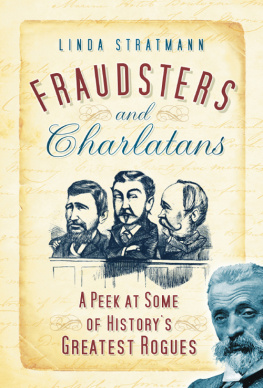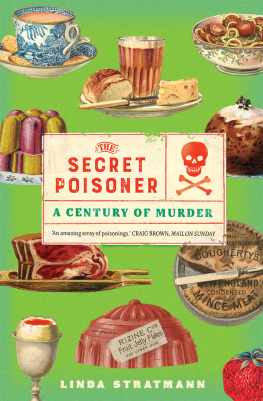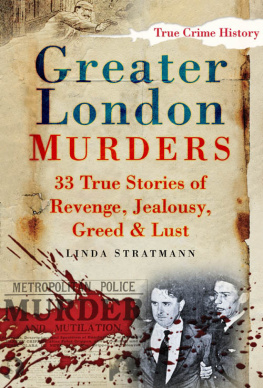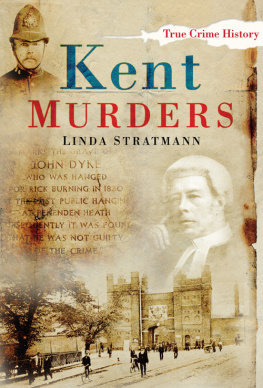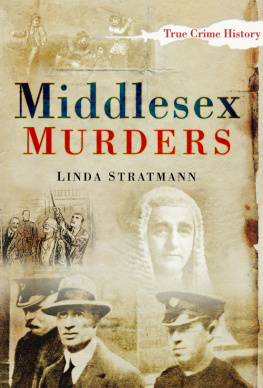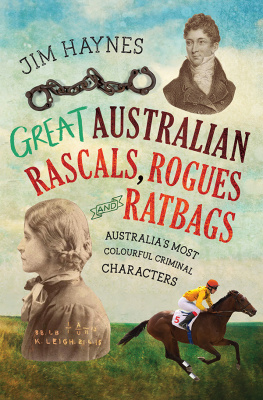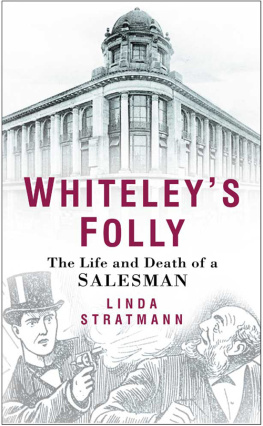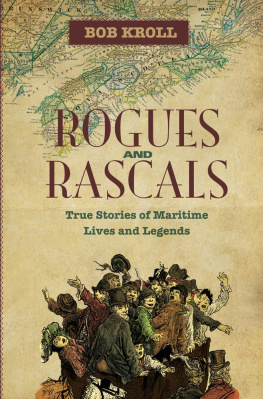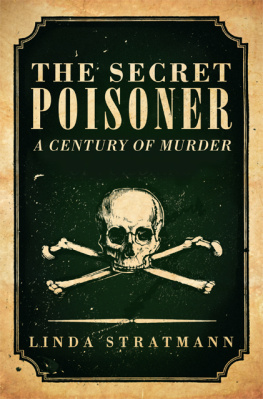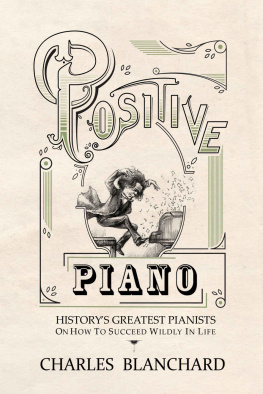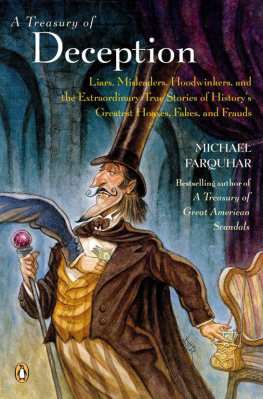Fraudsters
and
Charlatans
A P EEK AT S OME
OF H ISTORYS
G REATEST R OGUES
LINDA STRATMANN

Dedication
This book is dedicated with great affection to the memory of Janet Shepherd Figg (19572005), who sadly never saw it completed, but was always a good friend and an inspiration.
Previously published as The Crooks who Conned Millions in 2006
This edition published in 2010
The History Press
The Mill, Brimscombe Port
Stroud, Gloucestershire, GL 5 2 QG
www.thehistorypress.co.uk
This ebook edition first published in 2012
All rights reserved
Linda Stratmann, 2006, 2010, 2012
The right of Linda Stratmann, to be identified as the Author of this work has been asserted in accordance with the Copyrights, Designs and Patents Act 1988.
This ebook is copyright material and must not be copied, reproduced, transferred, distributed, leased, licensed or publicly performed or used in any way except as specifically permitted in writing by the publishers, as allowed under the terms and conditions under which it was purchased or as strictly permitted by applicable copyright law. Any unauthorised distribution or use of this text may be a direct infringement of the authors and publishers rights, and those responsible may be liable in law accordingly.
EPUB ISBN 978 0 7524 8695 6
MOBI ISBN 978 0 7524 8694 9
Original typesetting by The History Press
Acknowledgements
I would like to extend my grateful thanks to everyone who has helped me in the considerable research required for this book. The staff at the British Library, Colindale Newspaper Library, the Family Record Centre and the National Archives have, as always, all been enormously helpful. Many thanks also to Sarah Colbourne of the Hallward Library, University of Nottingham, Professor Paul Johnson of the London School of Economics and Sorrel Cittadino. A special thank-you is due to Eamon Dyas for his fascinating tour of The Times archives and Mary of the delightful www.missmary.com for unearthing a wonderful article about Mlle Lenormand. The unsung hero of all my work is my husband, Gary, who tolerates with good humour the many hours I spend sitting behind a door marked Go Away!
Introduction
T he nineteenth century was a time of optimism, with public confidence in the rewards of trade and exploration, and excitement at new inventions and discoveries. Never before had ordinary members of society had such a variety of opportunities to invest their humble savings in banks and businesses, and never before had rogues and charlatans of all kinds had a larger or richer field in which to perpetrate their frauds. Improvements in communications and travel brought a hunger for knowledge of the world, but this very eagerness sometimes led to uncritical acceptance of any story that seemed fresh and sensational. It is tempting to assume that people then were more gullible than we are today, but society encouraged an admiration of and implicit trust in the nobility, the educated and those with a conspicuous outward show of success. These figureheads were the heroes and superstars of the day, lauded by the popular press, respected by the masses, and their names alone were sufficient to lend credibility to any enterprise.
I have gathered ten stories, arranged chronologically, of some of the most audacious and extensive frauds of the nineteenth century. All had a disastrous impact on large numbers of people, and for some resulted in financial ruin, political disgrace, imprisonment, intellectual humiliation or suicide. All examine the crucial interface between the fraudster and the victim, since inevitably each wanted something from the other. The driving forces were money and celebrity. The methods of perpetrating the fraud may have differed word of mouth, masquerade, public announcements, pamphlets, official documents and outright forgery but all did no more than invite the victim into the snare. Entrapment occurred sometimes through trusting innocence and a need for financial security, sometimes from greed, often in the face of dire warnings from observers who were not swept along in the tide of enthusiasm. Those with a desire for fame and respect tried to boost their own standing by attaching themselves to an individual who had gained sudden publicity, and when the story was a good one, people just wanted it to be true. All these scenarios illustrate not only the depths to which people will sink to defraud others, but the scale of human credulity that provided them with so many victims.
In the stories that follow it is sometimes unclear who the hoaxer actually was. There can be no doubts about Whitaker Wright, whose personal control over an empire worth millions enabled him to falsify company accounts when he gambled away investors funds in shady Stock Exchange deals, but did George Hollamby Druce really mastermind his claim to the 16 million Portland estate or was he himself the tool of a crooked solicitor? Naval hero Thomas Cochrane went to prison for a colourful and complex fraud worthy of one of his great victories; but was he the victim of a miscarriage of justice?
A fraudster can often become his own victim. What starts as a carefully designed plot can develop into a personal obsession, until the boundary between falsehood and reality blurs. Fraudsters can come to believe passionately in the truth of their claims, and feel wronged and cheated of their rights to the end of their days, sometimes even passing the torch to their children. Alexander Humphrys undoubtedly knew exactly what he was doing when he forged documents showing he was the Earl of Stirling, but his later rantings speak of self-delusion and paranoia.
Most fraudsters refuse to admit guilt even in the face of overwhelming evidence of their crimes. Even Ernest Terah Hooley, who cheerfully stated that many of his deals were extremely dubious, still managed to convince himself that on balance he was a benefactor to society. Thousands of small investors would no doubt have disagreed with him.
Not all these fraudsters are unmitigated rogues. It is hard not to admire Mary Baker, the high-spirited shoemakers daughter who overcame her humble upbringing and conned the intellectuals of her day into believing she was a foreign princess. Others are less attractive, such as John Sadleir, the cold-hearted schemer who brought untold misery to the small farmers he represented in parliament.
We may hope that by studying past frauds we can protect ourselves in future, but there will always be fraudsters and there will always be victims: only the methods change. People still need to believe.
Linda Stratmann
ONE
The Price of Omnium
A t 1 a.m. on Monday 21 February 1814, John Marsh, keeper of the Packet Boat public house in Dover, was enjoying a quiet pipe with local hatter Thomas Gourley when he heard a violent and insistent knocking at the door of the Ship Inn opposite and a loud voice demand that a post-chaise and four be brought at once. The night was dark, bitterly cold and misty, yet Marsh left his warm fireside to see what was happening, calling to Gourley to follow him with candles. His curiosity was understandable, since Dover was on constant alert for news from the Continent.
This was a critical period in European history and a time of agonising public suspense. Following his disastrous Russian campaign of 1812, Napoleon was in retreat but far from beaten. Rejecting attempts by Britain and her Allies to negotiate a peace in November 1813, he concentrated his forces in France. In January and February 1814 Napoleons armies won a series of victories, which were eagerly followed in the British press. While the spectre of invasion had vanished, Napoleon alive, free and at the head of an army remained a potent threat. The peace of Europe depended on the fate of one man, and in Britain news of his final defeat was awaited with breathless expectation.
Next page
